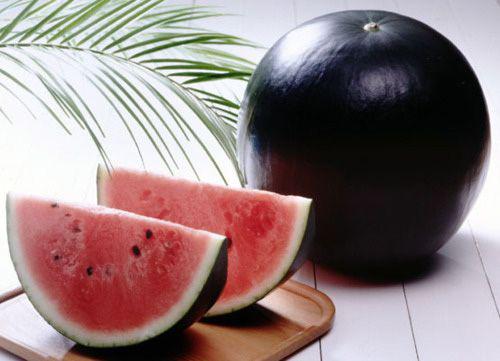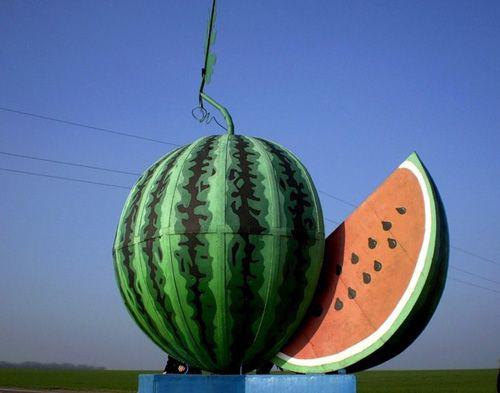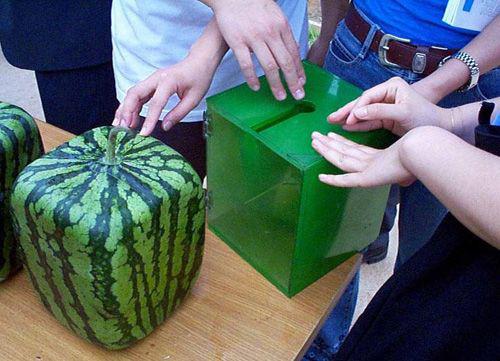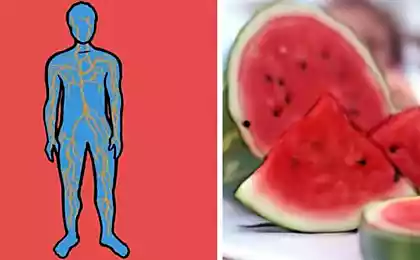1427
25 facts about watermelon (11 photos)
Round and square, giant and dwarf, red, yellow, orange and even black - it's all about watermelons! Want to know what the word "watermelon" why watermelon red, how to grow square watermelon and other interesting facts about these striped fruit? Then this article is for you!

1. Watermelon is 92% water. For comparison, jellyfish body consists of water by about 95%, the body of a newborn baby - 80%, while adult humans - by 65-70%.
2. The flesh of watermelon contains 5, 5-13% digestible natural sugars. By the time it is dominated maturation fructose and glucose, and sucrose accumulates during storage watermelon. Ripe saturated fructose which does not cause stress insulin in the pancreas. Therefore, small doses of watermelon can be used and diabetes.
3. Red watermelon flesh attached carotenoid pigment lycopene. Its content in watermelon is greater than any other fresh fruits or vegetables. The red pigment lycopene are also found in large quantities and determines the color of tomatoes, guava, grapefruit. Lycopene is a powerful natural antioxidant, it is able to prevent the development of cancerous tumors, it helps in male infertility, slows the aging process, reduces the risk of cancer in human prostate, uterus and esophagus.

4. The name of the Russian watermelon received from the Turkic word χarbuz / karpuz, which was borrowed from Persian. The word "harbyuza» (χarbūza, χarbuza) in Persian means "melon", but the literal meaning of the word - "a huge cucumber" or "ass the size of a cucumber».
5. Homeland watermelons is the Kalahari Desert in South Africa. There still are wild watermelon small size (with a tennis ball) and weighing about 200 grams. More than 4,000 years ago, we began to grow watermelons in ancient Egypt, as evidenced by found in Egyptian tombs image and watermelon seeds. Interestingly, the Egyptians often placed in the tombs of the pharaohs watermelons as a source of food in their afterlife. Later, began to cultivate watermelons in Persia (Iran), Arabia, India and other Asian countries with dry and hot climate.
6. In Western Europe watermelons brought in the era of the Crusades about 700-900 years ago. In Russia, watermelons were from the eastern and southern countries by sea via Astrakhan. But sow them rather than to import from other countries, it began only in the mid-17th century. In that distant time did not eat fresh watermelon. While watermelons for a long time brought to the king's table from abroad, they lose freshness and become unsuitable for fresh consumption. Therefore, watermelon eating only after a long soaking and cooking in sugar syrup with herbs and pepper! Even when the melons began to grow in Russia, they still long to eat fresh, and served in the palaces soaked in sugar syrup.

7. In Vietnam, there is an interesting tradition. During the celebration of the Vietnamese New Year ("Wall") on the table always served watermelons. It is believed that watermelon red symbolizes luck. A watermelon seeds are used as a snack.
8. In Ukraine, in the Kherson region (route Dnepropetrovsk - Kherson) is a monument of watermelon. Kherson watermelons long known in Ukraine and abroad.
9. watermelon - a berry, a fruit or vegetable? There is a widespread belief that a watermelon - a berry largest of all known science. In fact, the fruit of watermelon - a juicy melon polyspermous (lat. Pepo, peponium). Morphologically (structurally) melon like a berry, but differs from it by a large number of seeds and structure of the pericarp (fruit wall plants surrounding the seeds). Therefore, from the point of view of botany called watermelon berry fruit is not quite correct. Watermelon ordinary (lat. Citrúllus lanátus) - is an annual herb, gourds gourd family (Cucurbitaceae).
10. Today, there are more than 1,200 varieties of watermelons are grown in 96 countries around the world. This is mainly countries with warm climates.
11. Watermelon need a hot climate and a long period of maturation. They are planted after the ground warms up, and there is no likelihood of frost. Watermelons are grown well in the steppe and Mediterranean climate with long hot and dry summers and mild short winter.

12. World production of melons (watermelon, melon, pumpkin) increases. First place in the world in terms of production and sales of watermelon is China due to its huge agricultural land, cheap labor and hard work of the Chinese. The second place with a margin of almost 17 times takes Turkey.
Top 10 countries where most of watermelons are grown (according to 2007):
1. China - 63 million tons
2. Turkey - 3, 8 million tons
3. Iran - 3, 3 million tons
4. Brazil - 2 million tons
5. US - 1, 9 million tons
6. Egypt - 1, 9 million tons
7. Russia - 1 million tons
8. Mexico - 1 million tons
9. Uzbekistan - 840,000 tons
10. The Republic of Korea - 741 000 tonnes
13. The fruits of watermelon in shape, size and color can be very different from each other depending on the variety. Watermelons can be spherical, oval, flattened or cylindrical. Colouring the rind of watermelon ranging from white and yellow to dark green with a pattern of stripes, spots grid. But the flesh is red, pink, crimson, but sometimes there are watermelons with yellow or orange flesh.

14. Yellow melons are the result of interbreeding of wild yellow watermelon (which can not have) with the usual. Now the yellow-fleshed melons are grown in Spain and Thailand. In Spain they are growing in the summer and a circular shape are obtained. In Thailand, they are grown in the winter and have an oval shape. In Thailand yellow watermelons are very popular (especially among the Chinese, who buy them there), and there are 2 times more expensive than usual, as it is believed that the yellow color symbolizes gold and riches.
15. Experiments on the removal of yellow watermelon held in Ukraine. The Ukrainian breeders get a special hybrid "Kavbuz", which in yellow, looks and tastes like pumpkin and flavor reminiscent of watermelon. This variety is best suited for making porridge.
16. And breeders brought black watermelon! This unique watermelon belongs to the rare class Densuke and grown only on the island of Hokkaido in northern Japan. Vintage black watermelon is usually up to 10,000 units per year. The main differences grade Densuke - smooth dark skinned without the usual strips and watermelon taste, unlike other varieties of watermelons. Black watermelons have a strong loose flesh pink, fewer seeds and differ from conventional watermelons on the degree of sweetness. The fruits of the black melons are round and can reach a weight of 11 kg. In Japan, black melons are considered to be a luxury and usually presented as a gift. Their average market price in the store is about $ 250! And in June 2008, one of the first black watermelon grown specimens weighing 8 kilograms was sold at auction for 650,000 Japanese yen (6,300 dollars)! This watermelon, perhaps, be called the most expensive watermelon ever sold in Japan, and around the world.

17. Another Japanese invention - square watermelons. The first cubic watermelons were removed about 30 years ago in Kagawa Prefecture on the Japanese island of Shikoku. Then they appeared in the United Arab Emirates, Brazil, the UK and other European countries. Conventional round watermelons often ride their inconvenient to store or transport in a refrigerator. Therefore, Japanese farmers have come up with to put the watermelon ovary in special glass box in the form of a cube. During fetal growth took the form of boxes, which, incidentally, was the same size as the shelves of Japanese refrigerators. At the same taste qualities of melons are no different from the usual. Grow square watermelon at his dacha everyone can. To do this, place the watermelon ovary in a transparent box (glass or plastic) when it reaches the size of a tennis ball. The box shall be not less than 20h20h20 cm, tight-fitting lid, ventilation and slots for lashes. Similarly, you can grow a watermelon pyramid or cone-shaped, and not only watermelons and melons, pumpkins, squash, tomatoes, cucumbers. Square watermelons are more convenient to transport and store, they fit easily on a shelf of the refrigerator, take up less space and does not roll off the table. Their cultivation is more advantageous from a financial point of view. In addition, they look original, so in Japan these fruits are used for window dressing and interior. Only the square watermelons are much more expensive than usual - from 50 to 300 dollars, but it is in great demand.

18. The average weight watermelon ranges from 5 to 10 kg, and even less is more. And the biggest watermelon in the world is grown in the United States. The American farmer Lloyd Bright from Arkansas in 2005 has grown watermelon varieties Caroline Cross (Carolina Cross) weighing 122 kilograms (as is the average weight of two adults)! In the spring of 2006, the watermelon was recorded in the Guinness Book of Records. And the biggest watermelon grown in Europe, weighed 61 kg 4. This watermelon varieties "Russian size" farmer raised Igor Lihosenko of Temryuk District (Krasnodar, Russia) in 2009. It was said that the fruit was inoculated to the pumpkin, which is more developed root system, and it provided additional watermelon nutrition and growth.
19. However, apart from the huge watermelon, there are also dwarf melons. In South America, small watermelons are grown length of only 3-4 centimeters, called Pepquinos. The taste they resemble cucumber and are often used in expensive restaurants for the preparation of various salads, sorbet, or as an appetizer. They were found and brought to Europe in 1987, the Dutch company Koppert Cress, which then began to produce their seeds for sale. These mini-watermelons recently started to grow in the US and Asia, but they are already very popular.

20. The people believe that watermelons are "boys" and "girls" and that watermelon "girl" supposedly sweeter and have less seeds. In fact, it is a myth, especially given the fact that watermelon - a plant monoecious (ie male and female flowers are on the same individual). The flowers are unisexual have watermelons, ie they are either stamens (male flowers), or pistils (female flowers). And as to have only male flowers stamens, then they fruit is formed. In fact, all the fruits of watermelon women, because the fetus is formed from the pistil of a flower.
21. Watermelon - a low-calorie product. In 100 grams of watermelon contains only 30-38 calories. In addition, watermelon - a useful dietary product. There is even a so-called "watermelon diet" (or "watermelon starvation"), which helps to lose weight, cleanse the body of toxins and improve the functioning of the digestive system.
22. Nutritionists believe that in the absence of contraindications adult can consume 2-2, 5 kg of fresh watermelons on the day.

23. From the watermelon can be cooked many delicious and healthy dishes: a variety of salads, gazpacho, juice, sherbet, jam and candied watermelon peels, watermelon honey, and even the original ice for drinks. Watermelon canned, salted, pickled.
24. From the pulp of the watermelon makes a special honey "nardek." It is prepared by evaporating watermelon juice extracted from the pulp of ripe melons, honey until thick. To get only 1 kg watermelon honey, you need 16-17 kg of watermelon flesh sweet! Only nardek diabetics is not better, since it contains at least 60% sugar.

25. Masters of Asian carving watermelons are often used for cutting the incredible sculptures and flowers. Carving (from English «carving» - «cut») is an art - the art of cutting fruit and vegetables. Carving originated in China 2000 years ago, and in 1364 began to cut such jewelry in Thailand. Until 1932, this art form was only used to decorate royal ceremonies. Now the art of carving on fruits and vegetables possess worldwide.


1. Watermelon is 92% water. For comparison, jellyfish body consists of water by about 95%, the body of a newborn baby - 80%, while adult humans - by 65-70%.
2. The flesh of watermelon contains 5, 5-13% digestible natural sugars. By the time it is dominated maturation fructose and glucose, and sucrose accumulates during storage watermelon. Ripe saturated fructose which does not cause stress insulin in the pancreas. Therefore, small doses of watermelon can be used and diabetes.
3. Red watermelon flesh attached carotenoid pigment lycopene. Its content in watermelon is greater than any other fresh fruits or vegetables. The red pigment lycopene are also found in large quantities and determines the color of tomatoes, guava, grapefruit. Lycopene is a powerful natural antioxidant, it is able to prevent the development of cancerous tumors, it helps in male infertility, slows the aging process, reduces the risk of cancer in human prostate, uterus and esophagus.

4. The name of the Russian watermelon received from the Turkic word χarbuz / karpuz, which was borrowed from Persian. The word "harbyuza» (χarbūza, χarbuza) in Persian means "melon", but the literal meaning of the word - "a huge cucumber" or "ass the size of a cucumber».
5. Homeland watermelons is the Kalahari Desert in South Africa. There still are wild watermelon small size (with a tennis ball) and weighing about 200 grams. More than 4,000 years ago, we began to grow watermelons in ancient Egypt, as evidenced by found in Egyptian tombs image and watermelon seeds. Interestingly, the Egyptians often placed in the tombs of the pharaohs watermelons as a source of food in their afterlife. Later, began to cultivate watermelons in Persia (Iran), Arabia, India and other Asian countries with dry and hot climate.
6. In Western Europe watermelons brought in the era of the Crusades about 700-900 years ago. In Russia, watermelons were from the eastern and southern countries by sea via Astrakhan. But sow them rather than to import from other countries, it began only in the mid-17th century. In that distant time did not eat fresh watermelon. While watermelons for a long time brought to the king's table from abroad, they lose freshness and become unsuitable for fresh consumption. Therefore, watermelon eating only after a long soaking and cooking in sugar syrup with herbs and pepper! Even when the melons began to grow in Russia, they still long to eat fresh, and served in the palaces soaked in sugar syrup.

7. In Vietnam, there is an interesting tradition. During the celebration of the Vietnamese New Year ("Wall") on the table always served watermelons. It is believed that watermelon red symbolizes luck. A watermelon seeds are used as a snack.
8. In Ukraine, in the Kherson region (route Dnepropetrovsk - Kherson) is a monument of watermelon. Kherson watermelons long known in Ukraine and abroad.
9. watermelon - a berry, a fruit or vegetable? There is a widespread belief that a watermelon - a berry largest of all known science. In fact, the fruit of watermelon - a juicy melon polyspermous (lat. Pepo, peponium). Morphologically (structurally) melon like a berry, but differs from it by a large number of seeds and structure of the pericarp (fruit wall plants surrounding the seeds). Therefore, from the point of view of botany called watermelon berry fruit is not quite correct. Watermelon ordinary (lat. Citrúllus lanátus) - is an annual herb, gourds gourd family (Cucurbitaceae).
10. Today, there are more than 1,200 varieties of watermelons are grown in 96 countries around the world. This is mainly countries with warm climates.
11. Watermelon need a hot climate and a long period of maturation. They are planted after the ground warms up, and there is no likelihood of frost. Watermelons are grown well in the steppe and Mediterranean climate with long hot and dry summers and mild short winter.

12. World production of melons (watermelon, melon, pumpkin) increases. First place in the world in terms of production and sales of watermelon is China due to its huge agricultural land, cheap labor and hard work of the Chinese. The second place with a margin of almost 17 times takes Turkey.
Top 10 countries where most of watermelons are grown (according to 2007):
1. China - 63 million tons
2. Turkey - 3, 8 million tons
3. Iran - 3, 3 million tons
4. Brazil - 2 million tons
5. US - 1, 9 million tons
6. Egypt - 1, 9 million tons
7. Russia - 1 million tons
8. Mexico - 1 million tons
9. Uzbekistan - 840,000 tons
10. The Republic of Korea - 741 000 tonnes
13. The fruits of watermelon in shape, size and color can be very different from each other depending on the variety. Watermelons can be spherical, oval, flattened or cylindrical. Colouring the rind of watermelon ranging from white and yellow to dark green with a pattern of stripes, spots grid. But the flesh is red, pink, crimson, but sometimes there are watermelons with yellow or orange flesh.

14. Yellow melons are the result of interbreeding of wild yellow watermelon (which can not have) with the usual. Now the yellow-fleshed melons are grown in Spain and Thailand. In Spain they are growing in the summer and a circular shape are obtained. In Thailand, they are grown in the winter and have an oval shape. In Thailand yellow watermelons are very popular (especially among the Chinese, who buy them there), and there are 2 times more expensive than usual, as it is believed that the yellow color symbolizes gold and riches.
15. Experiments on the removal of yellow watermelon held in Ukraine. The Ukrainian breeders get a special hybrid "Kavbuz", which in yellow, looks and tastes like pumpkin and flavor reminiscent of watermelon. This variety is best suited for making porridge.
16. And breeders brought black watermelon! This unique watermelon belongs to the rare class Densuke and grown only on the island of Hokkaido in northern Japan. Vintage black watermelon is usually up to 10,000 units per year. The main differences grade Densuke - smooth dark skinned without the usual strips and watermelon taste, unlike other varieties of watermelons. Black watermelons have a strong loose flesh pink, fewer seeds and differ from conventional watermelons on the degree of sweetness. The fruits of the black melons are round and can reach a weight of 11 kg. In Japan, black melons are considered to be a luxury and usually presented as a gift. Their average market price in the store is about $ 250! And in June 2008, one of the first black watermelon grown specimens weighing 8 kilograms was sold at auction for 650,000 Japanese yen (6,300 dollars)! This watermelon, perhaps, be called the most expensive watermelon ever sold in Japan, and around the world.

17. Another Japanese invention - square watermelons. The first cubic watermelons were removed about 30 years ago in Kagawa Prefecture on the Japanese island of Shikoku. Then they appeared in the United Arab Emirates, Brazil, the UK and other European countries. Conventional round watermelons often ride their inconvenient to store or transport in a refrigerator. Therefore, Japanese farmers have come up with to put the watermelon ovary in special glass box in the form of a cube. During fetal growth took the form of boxes, which, incidentally, was the same size as the shelves of Japanese refrigerators. At the same taste qualities of melons are no different from the usual. Grow square watermelon at his dacha everyone can. To do this, place the watermelon ovary in a transparent box (glass or plastic) when it reaches the size of a tennis ball. The box shall be not less than 20h20h20 cm, tight-fitting lid, ventilation and slots for lashes. Similarly, you can grow a watermelon pyramid or cone-shaped, and not only watermelons and melons, pumpkins, squash, tomatoes, cucumbers. Square watermelons are more convenient to transport and store, they fit easily on a shelf of the refrigerator, take up less space and does not roll off the table. Their cultivation is more advantageous from a financial point of view. In addition, they look original, so in Japan these fruits are used for window dressing and interior. Only the square watermelons are much more expensive than usual - from 50 to 300 dollars, but it is in great demand.

18. The average weight watermelon ranges from 5 to 10 kg, and even less is more. And the biggest watermelon in the world is grown in the United States. The American farmer Lloyd Bright from Arkansas in 2005 has grown watermelon varieties Caroline Cross (Carolina Cross) weighing 122 kilograms (as is the average weight of two adults)! In the spring of 2006, the watermelon was recorded in the Guinness Book of Records. And the biggest watermelon grown in Europe, weighed 61 kg 4. This watermelon varieties "Russian size" farmer raised Igor Lihosenko of Temryuk District (Krasnodar, Russia) in 2009. It was said that the fruit was inoculated to the pumpkin, which is more developed root system, and it provided additional watermelon nutrition and growth.
19. However, apart from the huge watermelon, there are also dwarf melons. In South America, small watermelons are grown length of only 3-4 centimeters, called Pepquinos. The taste they resemble cucumber and are often used in expensive restaurants for the preparation of various salads, sorbet, or as an appetizer. They were found and brought to Europe in 1987, the Dutch company Koppert Cress, which then began to produce their seeds for sale. These mini-watermelons recently started to grow in the US and Asia, but they are already very popular.

20. The people believe that watermelons are "boys" and "girls" and that watermelon "girl" supposedly sweeter and have less seeds. In fact, it is a myth, especially given the fact that watermelon - a plant monoecious (ie male and female flowers are on the same individual). The flowers are unisexual have watermelons, ie they are either stamens (male flowers), or pistils (female flowers). And as to have only male flowers stamens, then they fruit is formed. In fact, all the fruits of watermelon women, because the fetus is formed from the pistil of a flower.
21. Watermelon - a low-calorie product. In 100 grams of watermelon contains only 30-38 calories. In addition, watermelon - a useful dietary product. There is even a so-called "watermelon diet" (or "watermelon starvation"), which helps to lose weight, cleanse the body of toxins and improve the functioning of the digestive system.
22. Nutritionists believe that in the absence of contraindications adult can consume 2-2, 5 kg of fresh watermelons on the day.

23. From the watermelon can be cooked many delicious and healthy dishes: a variety of salads, gazpacho, juice, sherbet, jam and candied watermelon peels, watermelon honey, and even the original ice for drinks. Watermelon canned, salted, pickled.
24. From the pulp of the watermelon makes a special honey "nardek." It is prepared by evaporating watermelon juice extracted from the pulp of ripe melons, honey until thick. To get only 1 kg watermelon honey, you need 16-17 kg of watermelon flesh sweet! Only nardek diabetics is not better, since it contains at least 60% sugar.

25. Masters of Asian carving watermelons are often used for cutting the incredible sculptures and flowers. Carving (from English «carving» - «cut») is an art - the art of cutting fruit and vegetables. Carving originated in China 2000 years ago, and in 1364 began to cut such jewelry in Thailand. Until 1932, this art form was only used to decorate royal ceremonies. Now the art of carving on fruits and vegetables possess worldwide.
























